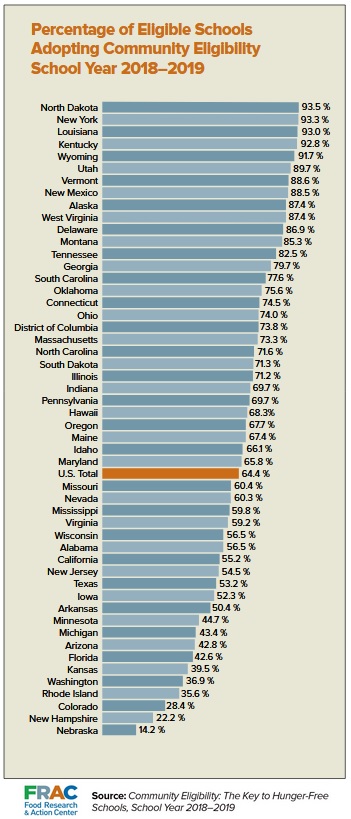Media Contact:
Emily Pickren
epickren@frac.org
202-640-1118
 Federal Program Offers a Solution to “Lunch
Federal Program Offers a Solution to “Lunch
Shaming”
WASHINGTON, June 1, 2019 — More students across the country are benefiting from community eligibility, a provision that allows high-poverty schools to offer free breakfast and lunch to all students, according to a report released today by the Food Research & Action Center. Community Eligibility: The Key to Hunger-Free Schools finds that the number of schools participating in community eligibility grew by 14 percent compared to the 2017–2018 school year, with 64.6 percent of eligible schools participating. Over 13.6 million children in 28,614 schools and 4,698 school districts are participating and have access to school breakfast and lunch at no charge.
Despite the progress made since community eligibility was first introduced nationwide five years ago, too many eligible schools and their students are still missing out on the benefits of the provision.
“Under community eligibility, participation in school breakfast and lunch increases, allowing more students to reap the many benefits of school meals, including improved academic achievement, better health, improved attendance, and fewer disciplinary referrals,” said James Weill, president of the Food Research & Action Center. “Plus, the stigma that school meals are only for low-income children also is eliminated.”
California experienced the largest growth, with 1,522 more schools implementing community eligibility since the 2017–2018 school year. Texas, New York, Michigan, and Florida added 646, 184, 173, and 214 more schools, respectively. Thirteen states have 80 percent or more of their eligible schools participating. (see graphic to the right)
Another benefit of community eligibility, since all students eat at no cost, is that participating schools and districts do not have to grapple with the issue of unpaid school meal debt. It eliminates “lunch shaming” of children who do not have money in hand or in their school meals account.
“The issue of student lunch debt is one that many school districts across the country are dealing with, and most people would agree that children should not go hungry because they cannot pay for school meals,” said Crystal FitzSimons, director of school and out-of-school time programs at the Food Research & Action Center. “Community eligibility is an important solution for unpaid school meal debt for high-poverty schools and districts.”
A school or district qualifies for community eligibility when at least 40 percent of its students are directly certified for free school meals, meaning they are automatically eligible because their families receive Supplement Nutrition Assistance Program (SNAP), Temporary Assistance for Needy Families (TANF), Food Distribution Program on Indian Reservations (FDPIR), and in some states, Medicaid benefits. Students who are homeless, migrant, runaways, in Head Start, and in foster care also can be directly certified for free school meals. FRAC’s community eligibility database shows which schools in each district, by state, are eligible or near-eligible for the provision.
To capitalize on the significant growth opportunities for community eligibility in the coming years, states and school districts can improve their direct certification system. Successful school districts can continue to share their experiences with their peers to help them understand the social, health, and financial benefits that community eligibility confers not just to students, but to families, schools, districts, and communities. Parents and education, health, and anti-hunger advocates can work with eligible but non-participating schools to explain the huge benefits of adopting community eligibility.
###
The Food Research & Action Center is the leading national nonprofit organization working to eradicate poverty-related hunger and undernutrition in the United States.

